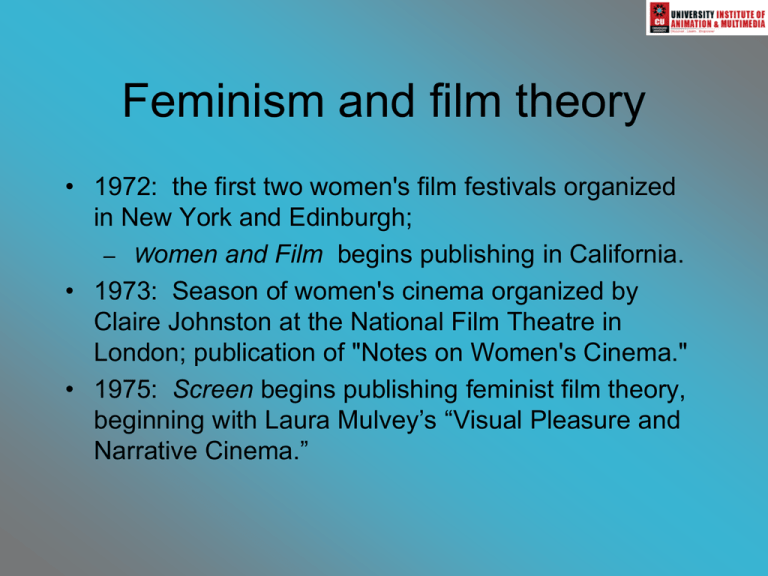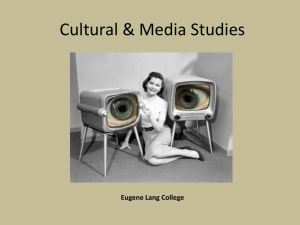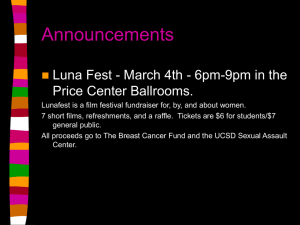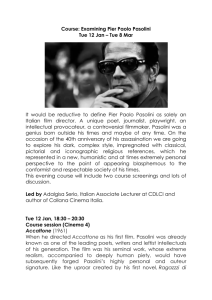
Feminism and film theory
• 1972: the first two women's film festivals organized
in New York and Edinburgh;
– Women and Film begins publishing in California.
• 1973: Season of women's cinema organized by
Claire Johnston at the National Film Theatre in
London; publication of "Notes on Women's Cinema."
• 1975: Screen begins publishing feminist film theory,
beginning with Laura Mulvey’s “Visual Pleasure and
Narrative Cinema.”
Feminism and film theory
• Essentialism: a core identity that defines women
psychologically. That there is a repressed, integral
experience appropriate to women's bodies and lives
– The objective of women's filmmaking (and history) is to
restore the visibility of women's experience to the screen, or
to replace negative images of women with positive ones.
• In contrast, the anti-essentialist position argues that
sexual difference was constructed in language and
through aesthetic forms.
Structural Theory and Psychoanalysis
• The early 1970s Claire Johnston was one of the first
to draw on semiotics and Lacanian psychoanalysis
suggesting:
• Cinema provides a male myth of “woman”
• Woman in classical cinema serve as an “empty sign”
exchanged by men; the object rather than the subject
of desire.
Johnston was critical of Hollywood cinema, but also saw
it as an important site for study and intervention.
She called for an alternative narrative cinema.
Structural Theory and Psychoanalysis
Together these two frameworks provide film theorists
with ways for thinking about how the viewer as a
subject participates in the meaning of the film.
• Semiotics--theory of signs. A tool for analyzing how
meaning is produced through language and ideology.
• Psychoanalytic theory. A theory of the subject as
constituted through sexual difference.
Laura Mulvey
•
•
•
•
•
•
Film Theorist, Media Scholar, Filmmaker
Great Britain (1941 - )
Feminist Film Studies
"Visual Pleasure and Narrative Cinema” - 1975
Psychoanalysis, Semiotics
Sustained dialog on how sexual difference is reproduced in the
act of watching classical cinema - 30s, 40s, 50s…
• Fascination of cinema
• She argues women have been placed in a specific,
powerless position in cinema.
• How does the cinematic system actively, and
passively, make this so?
Rear Window (1954), Alfred Hitchcock
•
•
•
•
Representation of women as an aspect of visual pleasure
Cinema reproduces gendered subjects
Men = active | Women= passive
You are positioned as spectator when you identify with the
characters
• Positioning of camera, lightning, the roles, all decisions set up
positions: you thought about yourself as the one looking and not
being looked at.
• Psychoanalytic theory as it is related to film culture; this is not
about psychoanalyzing characters, but mechanisms of viewing,
this is, spectatorship.
– More than the act of looking, the gaze is a viewing relationship,
characteristic of a particular set of social circumstances
• Even if it was wrong, it influenced a body of work that was very
influential
• Hypothesis: psychoanalysis + semiotics = understanding film
• Analysis does not have to always be tied up to economy or class
QuickTime™ and a
decompressor
are needed to see this picture.
Jimmy Stewart as Jeffries in Rear Window
• The conflict is resolved through one of two ways:
Sadistic narrative: woman must be
punished (usually death or marriage)
Fetishism: woman serves as
polished object — the ideal of perfect
beauty.
Female: lure and a threat of
castration -
• In cinema, the spectator is made to identify with the male look
because the camera films from the optical, pint of view of the
male character.
“Three Looks”
The characters in the film look at each other
The viewer looks at the screen
The camera looks at the event being filmed.
• Mulvey aims to disrupt pleasure
• Analysis / New Cinema
Hitchcock--as voyeur
QuickTime™ and a
decompressor
are needed to see this picture.
Grace Kelly as Lisa
• Pleasure functions in two ways:
• Scopophilia: pleasure in looking at objects.
• Narcissism: identification with on screen (male) as a
controlling figure.
• Within the order, women are the “other”: the empty object
through which identity is constructed. This becomes problematic
for women’s identity.
• This is where the idea of the women becoming an object in the
film arises.
Films with women
Mary Anne Doane and others began to consider the
female spectator in relation to “the Woman’s Film”
(during the 1940s there were many films that
featured female protagonists targeting female
audiences).
• A Letter to Three Wives, Joseph Mankiewicz, 1949
• Gentleman Prefer Blondes, Howard Hawks, 1953
Recent Feminist Film Theory
After the 1980s: an increase in films by women directors and with
complex representations of gender and sexuality
• An Angel at My Table, Jane Campion, 1989
• Things You Can Tell by Just Looking at Her, Rodrigo Garcia,
2000












![Mulvey, Laura. 1997. "Visual pleasure and narrative cinema [1975]."](http://s3.studylib.net/store/data/007529433_2-3b37ade34c5426b5e82121d5b330aac5-300x300.png)